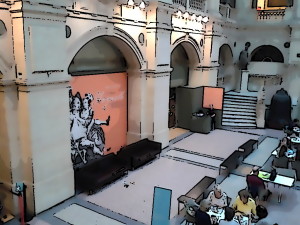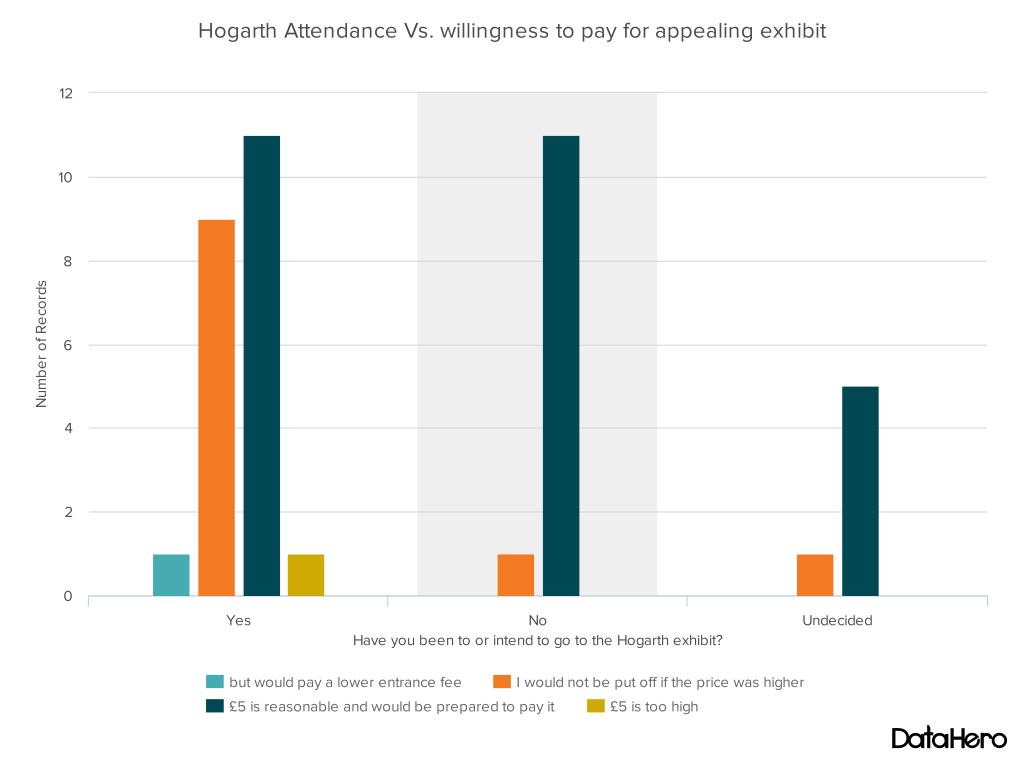It is only in the recent history of Bristol Museums, Galleries & Archives that we have been charging an entry fee for some of the temporary exhibitions – the first paid exhibition ‘Eye for Fashion’ took place in early 2012.
In the intervening time a number of approaches to pricing have been tried and tested including, for example, a ‘pay what you think’ model for the Photographic Portrait Prize in 2013. We are currently planning a similar model – ‘Pay what you can’ – for the Death exhibition (24 October 2015—13 March 2016). Over the past few years we have also been collecting data on pricing in the exhibition surveys via questions about ‘value for money’ – responses to which vary according to the exhibition in question. Despite having some data related to pricing, further research on pricing is needed. As such I undertook a short two week exploratory research project looking into temporary exhibition pricing and I discuss some of the findings here.
The research involved four days of survey collection whilst the Hogarth exhibition was on in Bristol Museum & Art Gallery (early July 2015).  The survey consisted of nine questions focused on the pricing of temporary exhibitions (see below). A total of 39 surveys were completed by a random sample of museum visitors. The key questions to highlight are three and four. These questions ask about firstly the price point of an exhibition that directly appeals to the visitor, and secondly about promotions that would help to incentivise exhibitions which have less direct appeal. The aim is to understand how pricing and promotion relate to different kinds of exhibitions.
The survey consisted of nine questions focused on the pricing of temporary exhibitions (see below). A total of 39 surveys were completed by a random sample of museum visitors. The key questions to highlight are three and four. These questions ask about firstly the price point of an exhibition that directly appeals to the visitor, and secondly about promotions that would help to incentivise exhibitions which have less direct appeal. The aim is to understand how pricing and promotion relate to different kinds of exhibitions.
- Have you been to or intend to go to the Hogarth exhibit? Y/N
- Did you come to the museum specifically to see the Hogarth exhibit? Y/N
- Thinking about an exhibition that appeals to you, which statement do you most agree with?
- I am unlikely to pay for a temporary exhibition
- £5 is too high, but would pay a lower entrance fee
- £5 is reasonable and would be prepared to pay it
- I would not be put off if the price was higher
- If you were unsure about paying to enter an exhibition, would any of the following promotions make you more likely to buy a ticket?
- Pay once and return as many times as you wish
- A discounted annual pass for temporary exhibits
- Discount in the Museum Cafe and Shop
- Discount for visits during quiet periods e.g. weekday mornings
- Free tea or coffee with adult ticket
- 2 for 1
- Family tickets
- 50% off promotion
- None
- Other (please specify)
- If we had a ticketing promotion how would you like to hear about it?
- Have you previously paid to visit a temporary exhibit in this museum or M-Shed? Y/N
- Have you previously paid to visit a temporary exhibit in other museums and art galleries? Y/N
- Have you bought anything in the shop or cafe on your visit? Y/N
- Do you understand why there is a charge for this exhibition and where the money raised from ticket fees goes? Y/N
In line with the previous visitor feedback on ‘value for money’, the results from the survey suggest that paid entry is not necessarily a barrier to visitors, nor is the current price point of £5. Moreover, the results potentially suggest that a higher price point would not always negatively affect the decision to pay for a temporary exhibition. Below I highlight two key findings and then suggest some further questions that may need addressing with further research.
Finding One
The graph below shows combined data from the Q.1 Have you been to or intend to go to the Hogarth exhibit? and Q.3. ‘Thinking about an exhibition that appeals to you, which statement do you most agree with?’. It shows the following:
- The majority (69%) of all respondents who had and had not been into Hogarth agree with the statement ‘£5 is reasonable and would be prepared to pay it’.
- Of the 22 users who had been to Hogarth, 41% agreed with the statement ‘I would not be put off if the price was higher’. A potential insight that the audience who are visiting Hogarth (60% over 55) would not be put off by higher ticket prices.
- Only a small minority (2.5%) of all respondents agreed with the statements ‘I am unlikely to pay for a temporary exhibition’ or ‘£5 is too high, but would pay a lower entrance fee’.
Wider Insight: There may be a need to re-assess the fixed price structure of £5/£4 con/Free U16s across all paid temporary exhibitions in order to maximise the different offers of each one. We know that different exhibitions appeal to different audiences and therefore further research may be needed on how prices points are perceived by key target audiences for each exhibition.
Finding Two
The graph below shows data for Q.4 – ‘If you were unsure about paying to enter an exhibition, would any of the following promotions make you more likely to buy a ticket?’ It shows the following:
- 85% of users selected at least one pricing incentive option which would make them more likely to buy a ticket for an exhibit they were unsure about. 15% selected the ‘none’ option, meaning they would not be convinced by a pricing incentive to buy a ticket for an exhibit they were unsure about.
- The most popular discount pricing options were ‘2 for 1’ (41%) and ‘Free tea or coffee with an adult ticket’ (28%). This result is perhaps unsurprising, however, pricing discounts would need further research.
- The ticketing schemes we presented were also popular. The option of ‘pay once and return as many times as you wish’ was selected by 31% of users and the Discounted Annual pass was selected by 15%.
- Of those who said they had paid for exhibition in Bristol Museum and Art Gallery or M-Shed previously (Q.6), 28% selected an annual pass. This may indicate a stronger desire for an annual pass from already returning visitors.
Wider Insight: The data in this graph is indicative of openness among users to re-consider exhibits that they are unsure about given the right pricing incentive or promotion. This needs further investigation, including experimenting with pricing incentives.
Emerging questions and issues
As hoped at the outset of this short piece of research, a number of questions and issues emerged which need further investigation. The first one concerns what place temporary exhibitions have in the overall experience of a museum visit, for example, ‘are visitors using multiple offers in the museum: the permanent exhibitions, the temporary exhibitions (paid and free), the shop, and the café?’ Related to this, there is a need to better understand how temporary exhibitions relate to other paid-for elements in the museum. For example, ‘if the café is currently doing well, should we use its success as a means to increase visitor spend in the shop and in temporary exhibits (i.e. use the café as a direct marketing opportunity)?’
Perhaps the widest reaching insight, which would require further research, is that arguably the primary barrier to entry to any given exhibition remains a perceived lack of interest in a given exhibition. Previous research from the Hidden Museum project, however, revealed that a perceived lack of interest among visitors is often founded on assumptions and bias, but that this can be resolved given the right tools and approach.
Finally, it is part of my task as the new user researcher (audience development) to design and facilitate research which can address these questions and feed the findings back into decisions about how we shape the temporary exhibition offers that we have across Bristol Museums, Galleries & Archives.
If you have any questions about the digital or audience development research we do at Bristol Museums, Galleries & Archives feel free to get in touch with me darren.roberts@bristol.gov.uk

